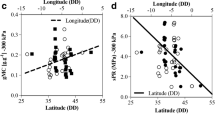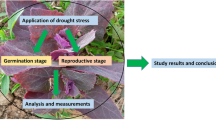Abstract
Key message
The different germination behaviours of the seeds under induced water limitations may be related to the different adaptive capacities acquired at the diverse collection sites, as a response to the different environmental parameters. The island of Pianosa resulted the most performant in term of germination responses and the co-occurrence of xeromorphic anatomical evidences at root level confirmed this trend.
Abstract
Regeneration from seeds is an important co-determinant in the invasion ecology of black locust. In the attempt of providing new information on its invasion potential in Mediterranean Europe under the future scenario of global warming, we investigated the effects of induced water-deficit regimes on: (1) seed germination performance and (2) root growth and anatomy. Ripe seeds were collected from four populations established in Tuscany (Central Italy): mechanically scarified seeds were incubated in a range (− 0.2/− 0.8 MPa) of constant water stress conditions at 21 °C. The final germination rate drastically declined with increasing induced water-deficit conditions, with the highest value at control and at − 0.2 MPa (ca 50–97%), and the lowest at − 0.6 MPa (ca 10–33%). The mean germination time decreased with increasing water stress. At root level, xeromorphism relies on the combination of different anatomical traits which co-optimize water uptake/loss: thinner roots, higher number of xylem vessels, vessels with small-sized lumen and thinner cell walls. Seeds collected in sites characterized by different environmental parameters display a noteworthy difference in the germination dynamics: as far as the beginning and ongoing of germination, as well as the germination response in time is concerned, the seeds from the island of Pianosa showed the highest performance; the major arid conditions in Pianosa could have caused a “stress imprint” able to facilitate a fast and protective response to future drought events. As a whole, our results confirmed the great phenotypic plasticity of black locust as a response to variable water availability and provided evidence for the potential high germination capacity in drier environments, as seems to be the future Mediterranean Europe.





Similar content being viewed by others
References
Beccari N, Mazzi V (1966) Manuale di tecnica microscopica: guida pratica alla ricerca istologica e istochimica. Società Editrice Libraria, Milano
Belokopytova LV, Babushkina EA, Zhirnova DF et al (2018) Pine and larch tracheids capture seasonal variations of climatic signal at moisture-limited sites. Trees. https://doi.org/10.1007/s00468-018-1772-2
Benjamini Y, Hochberg Y (1995) Controlling the false discovery rate: a practical and powerful approach to multiple testing. J R Stat Soc Ser B 57:289–300
Bouteiller XP, Barraquand F, Garnier-Géré P, Harmand N, Laizet YH, Raimbault A, Mariette S (2018) No evidence for genetic differentiation in juvenile traits between Belgian and French populations of the invasive tree Robinia pseudoacacia. Plant Ecol Evol 151:5–17
Bradford K (2002) Applications of hydrothermal time to quantifying and modelling 78 seed germination and dormancy. Weed Sci 50:248–260
Bruce TJ, Matthes MC, Napier JA, Pickett JA (2007) Stressful “memories” of plants: evidence and possible mechanisms. Plant Sci 173:603–608
Cabra-Rivas I, Castro-Díez P (2016) Comparing the sexual reproductive success of two exotic trees invading Spanish riparian forests vs. a native reference. PLoS One 11:e0160831
Calamassi R, Della Rocca G, Falusi M, Paoletti E, Strati S (2001) Resistance to water stress in seedlings of eight European provenances of Pinus halepensis Mill. Ann For Sci 58:663–672
Chamorro D, Luna B, Ourcival JM, Kavgacı A, Sirca C, Mouillot F, Arianoutsou M, Moreno JM (2017) Germination sensitivity to water stress in four shrubby species across the Mediterranean Basin. Plant Biol 23:23–31
Cierjacks A, Kowarik I, Joshi J, Hempel S, Ristow M, Lippe M, Weber E (2013) Biological Flora of the British Isles: Robinia pseudoacacia. J Ecol 101:1623–1640
Core Team R (2017) R: a language and environment for statistical computing. R Foundation for Statistical Computing, Vienna
De Martonne E (1926) Une nouvelle fonction climatologique: l’indice d’aridité. Meteorologie 2:449–458
De Micco V, Aronne G (2012) Morpho-anatomical traits for plant adaptation to drought. In: Aroca R (ed) Plant responses to drought stress. Springer, Berlin, pp 37–61
Ellis RH, Roberts EH (1980) The influence of temperature and moisture on seed viability in barley (Hordeum distichum L.). Ann Bot 45:31–37
Giuliani C, Lazzaro L, Mariotti Lippi M, Calamassi R, Foggi B (2015) Temperature-related effects on the germination capacity of black locust (Robinia pseudoacacia L., Fabaceae) seeds. Folia Geobot 50:275–282
Hose E, Clarkson DT, Steudle E, Hartung W (2001) The exodermis: a variable apoplastic barrier. J Exp Bot 52:2254–2264
Jastrzębowski S, Ukalska J, Kantorowicz W, Klisz M, Wojda T, Sułkowska M (2017) Effects of thermal-time artificial scarification on the germination dynamics of black locust (Robinia pseudoacacia L.) seeds. Eur J For Res 136:471–479
Jin TT, Fu BJ, Liu GH, Wang Z (2011) Hydrologic feasibility of artificial forestation in the semi-arid Loess Plateau of China. Hydrol Earth Syst Sci 15:2519
Johansen DA (1940) Plant microtechnique. McGraw-Hill Book Co, New York
Kay M, Wobbrock J (2016) ARTool: Aligned Rank Transform for Nonparametric Factorial ANOVAs. R package version 0.10.2. Retrieved from R package version 0.10.2
Kleinbauer I, Dullinger S, Peterseil J, Essl F (2010) Climate change might drive the invasive tree Robinia pseudacacia into nature reserves and endangered habitats. Biol Conserv 143:382–390
Lazzaro L, Mazza G, d’Errico G, Fabiani A, Giuliani C, Inghilesi AF, Lagomarsino A, Landi S, Lastrucci L, Pastorelli R, Roversi PF, Torrini G, Tricarico E, Foggi B (2018) How ecosystems change following invasion by Robinia pseudoacacia: insights from soil chemical properties and soil microbial, nematode, microarthropod and plant communities. Sci Tot Environ 622–623:1509–1518
Mantovani D, Veste M, Freese D (2014a) Black locust (Robinia pseudoacacia L.) ecophysiological and morphological adaptations to drought and their consequence on biomass production and water use efficiency. N Ze J For 44:29
Mantovani D, Veste M, Freese D (2014b) Effects of drought frequency on growth performance and transpiration of young black locust (Robinia pseudoacacia L). Int J For Res. https://doi.org/10.1155/2014/821891
Meinzer FC, McCulloh KA, Lachenbruch B, Woodruff DR, Johnson DM (2010) The blind men and the elephant: the impact of context and scale in evaluating conflicts between plant hydraulic safety and efficiency. Oecologia 164:287–296
Michel BE, Kaufmann MR (1973) The osmotic potential of polyethylene glycol 6000. Plant Physiol 51:914–916
Mitrakos K (1980) A theory for Mediterranean plant life. Acta Oecol 1:245–252
Morimoto J, Kominami R, Koike T (2010) Distribution and characteristics of the soil seed bank of the black locust (Robinia pseudoacacia) in a headwater basin in northern Japan. Landsc Ecol Eng 6:193–199
Nicotra AB, Atkin OK, Bonser SP, Davidson AM, Finnegan EJ, Mathesius U, van Kleunen M (2010) Plant phenotypic plasticity in a changing climate. Trend Plant Sci 15:684–692
Onofri A, Benincasa P, Mesgaran MB, Ritz C (2018) Hydrothermal-time-to-event models for seed germination. Eur J Agron 101:129–139
Pedrol N, Puig CG, López-Nogueira A, Pardo-Muras M, González L, Souza-Alonso P (2017) Optimal and synchronized germination of Robinia pseudoacacia, Acacia dealbata and other woody Fabaceae using a handheld rotary tool: concomitant reduction of physical and physiological seed dormancy. J For Res. https://doi.org/10.1007/s11676-017-0445-0
Pyšek P, Richardson DM (2008) Traits associated with invasiveness in alien plants: where do we stand? Biological invasions. Springer, Berlin, pp 97–125
Reichstein M, Bahn M, Ciais P, Frank D, Mahecha MD, Seneviratne SI et al (2013) Climate extremes and the carbon cycle. Nature 500:287–295
Shao HB, Chu LY, Jaleel CA, Zhao CX (2008) Water-deficit stress-induced anatomical changes in higher plants. Compt Rend Biol 331:215–225
Toumi M, Barris S, Seghiri M, Cheriguene H, Aid F (2017) Effect of several methods of scarification and osmotic stress on seed germination of Robinia pseudoacacia L. Compt Rend Biol 340:264–270
Tozer MG, Ooi MK (2014) Humidity-regulated dormancy onset in the Fabaceae: a conceptual model and its ecological implications for the Australian wattle Acacia saligna. Ann Bot 114:579–590
Verslues PE, Agarwal M, Katiyar-Agarwal S, Zhu J, Zhu JK (2006) Methods and concepts in quantifying resistance to drought, salt and freezing, abiotic stresses that affect plant water status. Plant J 45:523–539
Vítková M, Tonika J, Müllerová J (2015) Black locust—successful invader of a wide range of soil conditions. Sci Total Environ 505:315–328
Vítková M, Müllerová J, Sádlo J, Pergl J, Pyšek P (2017) Black locust (Robinia pseudoacacia) beloved and despised: a story of an invasive tree in Central Europe. For Ecol Manag 384:287–302
Walter J, Jentsch A, Beierkuhnlein C, Kreyling J (2013) Ecological stress memory and cross stress tolerance in plants in the face of climate extremes. Environ Exp Bot 94:3–8
Wickham H (2016) ggplot2: elegant graphics for data analysis. Springer, Berlin
Wobbrock JO, Findlater L, Gergle D, Higgins JJ (2011) The aligned rank transform for nonparametric factorial analyses using only anova procedures. In: Proceedings of the SIGCHI conference on human factors in computing systems. ACM. pp 143–146
Yang B, Peng C, Harrison SP, Wei H, Wang H, Zhu Q, Wang M (2018) Allocation mechanisms of non-structural carbohydrates of Robinia pseudoacacia L. seedlings in response to drought and waterlogging. Forests 9:754
Acknowledgements
The authors wish to thank Prof. Andrea Onofri (University of Perugia) for his valuable suggestions on the implementation of time-to-event hydro-time models and Mr. Corrado Tani for the useful technical support in the morphological survey.
Author information
Authors and Affiliations
Corresponding author
Additional information
Communicated by Noguchi.
Publisher's Note
Springer Nature remains neutral with regard to jurisdictional claims in published maps and institutional affiliations.
Rights and permissions
About this article
Cite this article
Giuliani, C., Lazzaro, L., Calamassi, R. et al. Induced water stress affects seed germination response and root anatomy in Robinia pseudoacacia (Fabaceae). Trees 33, 1627–1638 (2019). https://doi.org/10.1007/s00468-019-01885-8
Received:
Accepted:
Published:
Issue Date:
DOI: https://doi.org/10.1007/s00468-019-01885-8




